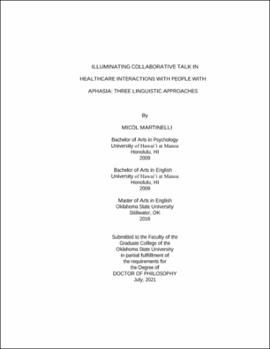| dc.contributor.advisor | Moder, Carol L. | |
| dc.contributor.author | Martinelli, Micol | |
| dc.date.accessioned | 2022-01-21T19:19:56Z | |
| dc.date.available | 2022-01-21T19:19:56Z | |
| dc.date.issued | 2021-07 | |
| dc.identifier.uri | https://hdl.handle.net/11244/333766 | |
| dc.description.abstract | The works collated here provide evidence of the benefits of viewing communication with people with aphasia (PWA) as a joint interactional process and of applying linguistic methodologies to the study of discourse and interaction in aphasia. They specifically point to the need to reconceptualize familiarization and speaking for behaviors in healthcare and allied healthcare fields with the objective of enhancing PWA's communicative access. Study 1 gave voice to PWA about their experiences, goals and objectives, and interactions with healthcare professionals. It also investigated collaboration in triadic interactions in which the person with aphasia has a post onset time of 10 or more years through the use of Croteau et al.'s (2007) procedure to analyze contributions and participation in interview settings. Findings suggest that deficit-oriented measures of contributions may obscure how certain communicative behaviors can actually enhance or maintain the participation of PWA, at least in experienced pairs. Study 2 investigated the use of collaborative forms of talk between healthcare students and PWA, through a conversation analytic approach, with a focus on information exchange. Findings show that students were able to engage in collaborative behaviors even without formal training. However, occasions in which turns were left incomplete, no candidate understandings were provided, or no joint production or repair sequences were initiated led to issues with progressivity, missed opportunities to check understanding, and possibly even loss of information. Through an analysis of presuppositions and implicatures, Study 3 explored how the members of a care team in a skilled nursing home perceive communication with PWA. Findings suggest that institutional culture shapes the general goals of practice and thus may uniformly mold the way providers perceive facilitators and barriers of those goals. Perceptions and opinions on training and interprofessional collaboration, on the other hand, did not appear as uniform within the team. Conclusions about some of the barriers to communicative access in healthcare settings are framed within discussion of reasons for limited engagement in collaborative forms of talk by providers. Suggestions are given on how these results and the linguistic methodologies which helped uncover them can be used to rethink concepts and practices. | |
| dc.format | application/pdf | |
| dc.language | en_US | |
| dc.rights | Copyright is held by the author who has granted the Oklahoma State University Library the non-exclusive right to share this material in its institutional repository. Contact Digital Library Services at lib-dls@okstate.edu or 405-744-9161 for the permission policy on the use, reproduction or distribution of this material. | |
| dc.title | Illuminating collaborative talk in healthcare interactions with people with aphasia: Three linguistic approaches | |
| dc.contributor.committeeMember | Preston, Dennis R. | |
| dc.contributor.committeeMember | Caplow, Nancy J. | |
| dc.contributor.committeeMember | Freeman, Valerie | |
| osu.filename | Martinelli_okstate_0664D_17273.pdf | |
| osu.accesstype | Open Access | |
| dc.type.genre | Dissertation | |
| dc.type.material | Text | |
| dc.subject.keywords | aphasia | |
| dc.subject.keywords | collaborative talk | |
| dc.subject.keywords | communicative access | |
| dc.subject.keywords | conversation analysis | |
| dc.subject.keywords | healthcare | |
| dc.subject.keywords | sociolinguistics | |
| thesis.degree.discipline | English | |
| thesis.degree.grantor | Oklahoma State University | |
